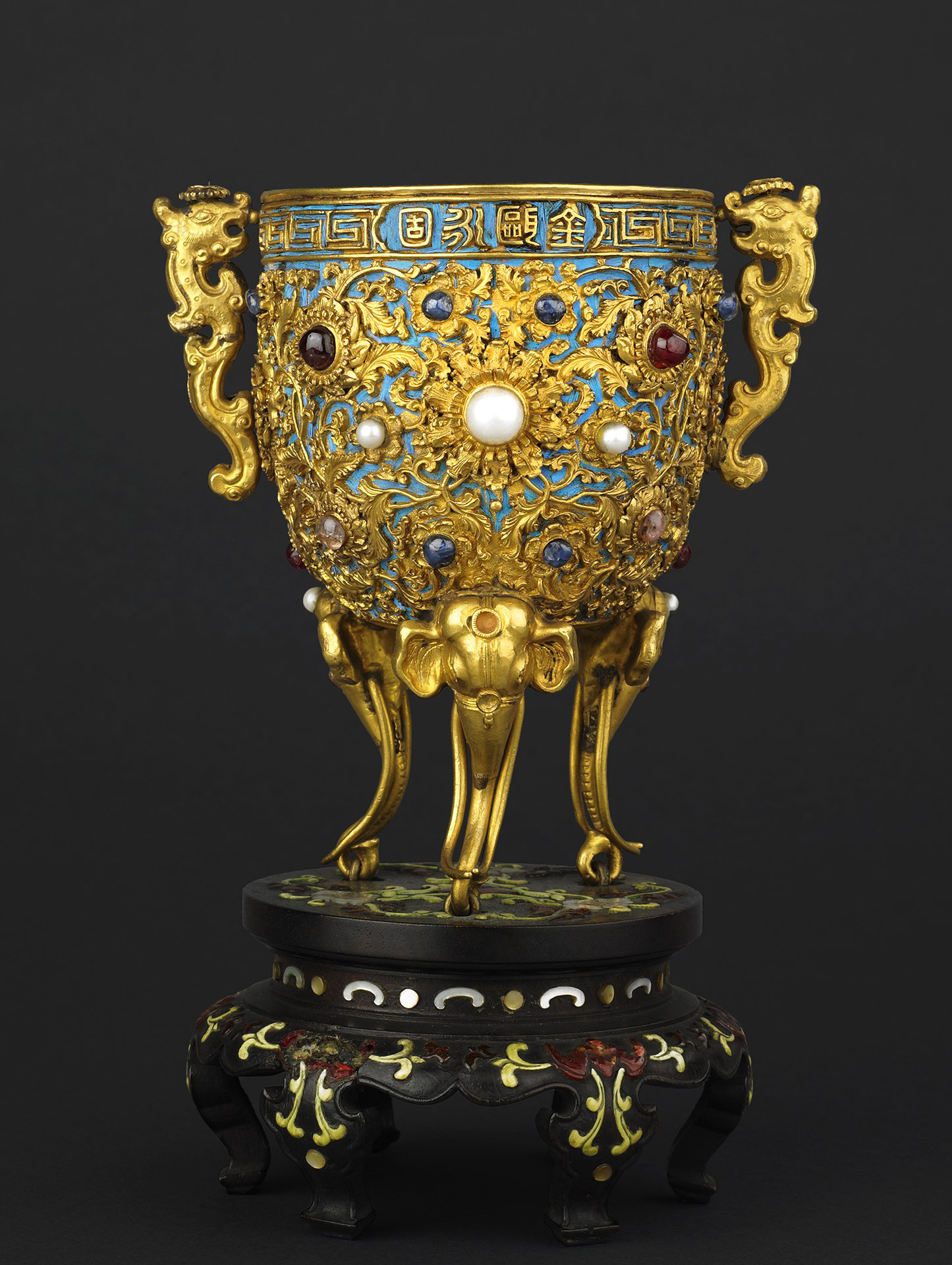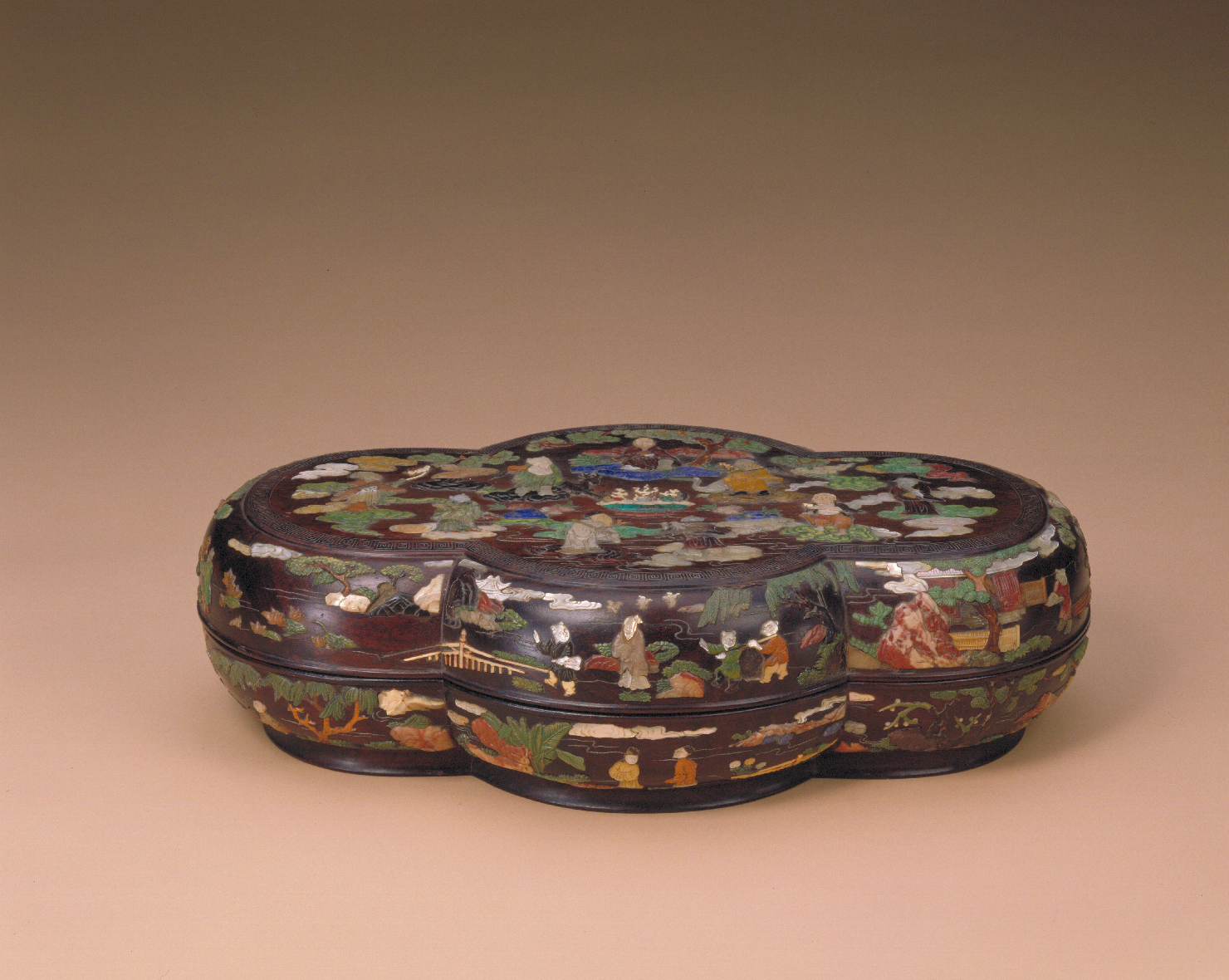Rich and Delicious
In his book The Way of Eating, the Qing Dynasty gourmet Yuan Mei (1716 – 1797) wrote under the “Essential Knowledge: Tableware” section that “To have good food, it might be better to have fine tableware…. It should be noted as follows: food more suited for bowls should be served in bowls; food suited for plates, on plates; sizable food items should be served in larger tableware; small items in smaller tableware. Served in a staggered order, they add so much more appeal to the meal”. This illustrates the close relationship between food and tableware. Fine tableware and delicious food complement each other, adding to the dining experience in the palace. Some of the most precious treasures of the world and the most exquisite cuisine in the country can be found at the Forbidden City. Fine tableware fit for serving imperial dishes were therefore also in its collection.
The Forbidden City 100: Imperial Cooking
Retrieved from: CCTV Documentary Channel on YouTube
Milk Tea with Salt and No Sugar?
Hong Kong-style milk tea, also known as “silk stocking milk tea”, is one of the biggest food cultural icons of the city. It is usually made with black tea and evaporated milk for a rich and smooth texture. The tea-making technique is recognized as one of the intangible cultural heritages of Hong Kong. The Qing court enjoyed milk tea just as much as people today do. What is the difference between the milk tea in the Qing Dynasty and what we usually drink now?
The Qing court continued the nomadic tradition of making milk tea by brewing milk, butter and tea together. The drink was rich, milky, fatty and nourishing. Most importantly, salt was added. As it turns out, the milk tea served at the Qing court was savoury! Precedents of The Collected Statues of the Qing Dynasty details the number of milk cows allotted to people of different ranks during the reign of Emperor Qianlong, viz., the empress dowager, the empress and the emperor, the imperial noble consorts, the noble consorts, as well as the imperial princes and their consorts. It seems that the realities of the court limited the enjoyment of milk tea. The comprehensive and meticulous regulations on ranks also reflected how popular milk tea drinking was in the palace.

White jade bowl with gold and ruby floral design, Qing Dynasty
White jade bowl with gold and ruby floral design, Qing Dynasty
Provided by the Palace Museum
This white jade bowl looks exceptionally lavish inlaid with gold leaves and 108 gemstones that complement each other. It is no wonder that the Qianlong Emperor wrote a poem in praise of it: “Boiled milk with buttermilk, the jade bowl resembles mutton fat”. He explains in his annotation to the poem that he bestowed milk tea during imperial ceremonies to show his benevolence and cement relations. The presentation of milk tea was a high-profile ritual during state-level celebratory ceremonies, intended to strengthen the camaraderie between the emperor and his officials.

Stone-inlaid cloisonné enamel ewer with interlocking lotus pattern, Qianlong mark, Qing Dynasty
Stone-inlaid cloisonné enamel ewer with interlocking lotus pattern, Qianlong mark, Qing Dynasty
Provided by the Palace Museum
Known as a duomuhu, this distinctive-looking vessel is used by the Mongols and Tibetans to hold milk. Its name is derived from a Tibetan word mdong-mo meaning ‘butter tea barrel’. It was often used by the emperor during his hunting trips.


Silver filigree milk tea bowl, Qing Dynasty
Silver filigree milk tea bowl, Qing Dynasty
Provided by the Palace Museum
The body of the bowl is made with filigree techniques, which involve stretching silver into thin wires and forming patterns with them. Soldering the filigree to the outside of the bowl also helps prevent scalding.
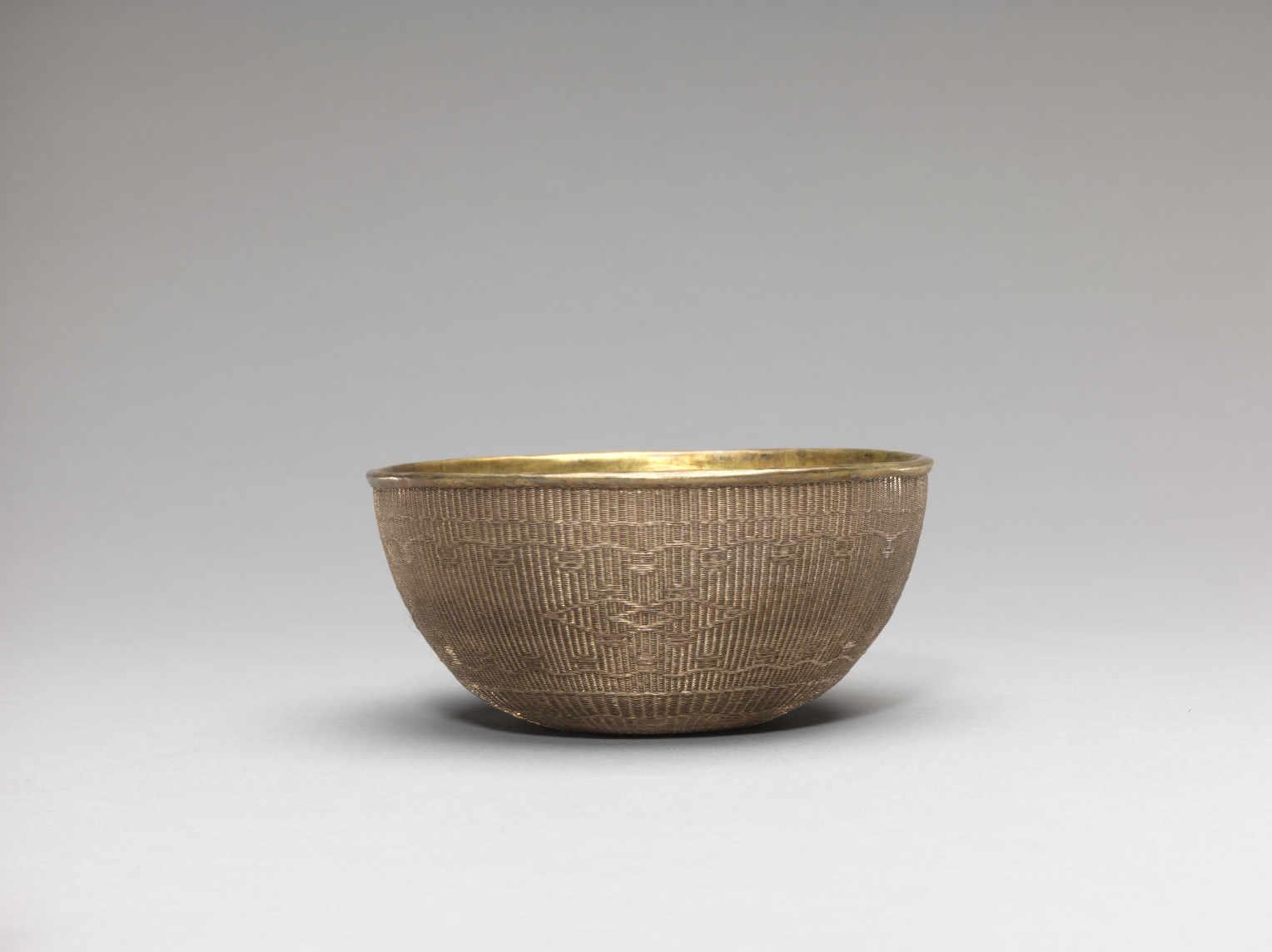
Coffee
Today many people may begin their morning with a cup of coffee. Coffee came to China roughly after the middle of the 19th century, along with Western cuisine. At first, there was no standard translation for the word, leading to interesting transliterations such as gaofei, kefei, and jiafei. There were already Western restaurants during the reign of Guangxu (1875 – 1908) in the Qing Dynasty, and later they became even more popular. Coffee was already popular with the upper class at the time – according to an anecdote from Anthology of Petty Matters in Qing, Yuan Shikai (1859 – 1916) ate six eggs and drank a large cup of coffee or tea for breakfast every morning. After coffee was introduced to Hong Kong, it not only became a fashionable drink, but also a symbol of status.
How did people drink coffee more than 100 years ago? As the American missionary Martha Foster Crawford (1830 - 1909) instructed in Foreign Cookery in Chinese, a textbook for Chinese Western chefs: “Roast the coffee over a strong fire, stirring regularly to keep it from burning and turning black. Once roasted, add a little cream while it is still hot, and store in a lidded jar. Grind it when you want to use it.”. Coffee was often drunk with milk. The late-Qing poet Mao Yuanzheng (1875-1931) mentioned drinking coffee in his poem:
“I drank coffee and forgot to stir in milk;
Milk tastes of sweetness and happiness, coffee tastes like my bitterness.”
It seems like it was not common at the time to take black coffee and people preferred drinking it with milk. There was already ground coffee in the late-Qing Dynasty. According to Formosa (now known as Taiwan, China) and Its Inhabitants, written by the American naturalist Joseph Beal Steere (1842 - 1940), a missionary gifted ground coffee to an old woman in 1874 and taught her to drink it by boiling it with sugar.

The Silver coffee ware – pot with bamboo-shaped double handles, Qing Dynasty
The Silver coffee ware – pot with bamboo-shaped double handles, Qing Dynasty
Provided by the Palace Museum
The Forbidden City incorporated Chinese elements into the designs of its coffee vessels – the knob on the lid, handles, feet and spout of these three pieces of coffee ware are all designed to imitate bamboo. Similar in form, they also share the same decorative themes of dragons playing with pearls, flowers, and bamboo leaves, as well as Chinese-style patterns of figures and houses.


Silver coffee ware – drinkware with bamboo-shaped handle, Qing Dynasty
Silver coffee ware – drinkware with bamboo-shaped handle, Qing Dynasty
Provided by the Palace Museum
The Forbidden City had a collection of coffee ware made in silver, enamel, copper and porcelain. A fusion of Chinese and Western styles, this silver set is a particularly fine item that testifies to the coffee-drinking culture of the time.


Silver coffee ware – sugar bowl with bamboo-shaped handle and tongs, Qing Dynasty
Silver coffee ware – sugar bowl with bamboo-shaped handle and tongs, Qing Dynasty
Provided by the Palace Museum


Silver coffee ware, Qing Dynasty
Silver coffee ware, Qing Dynasty
Provided by the Palace Museum
A glass washer that contains silver coffee ware. The handles of the spoons are cast in the shape of Qing Dynasty officials.

Rich and Velvety Wine
China has a long history of wine culture, with wine playing an indispensable part in sacrificial offerings and banquets. The Forbidden City houses a rich collection of wine-related vessels. Materials used for these drinking vessels include porcelain, gold, silver, rhino horn, enamel and jadeite.
Drinking may make one feel good, but it must be done moderately. This is a reminder from ancient Chinese. In Ming Shilu (Veritable Records of the Ming Dynasty), there is an account of Emperor Taizu holding up temperance as a social responsibility and making it an imperial edict. In the Qing Dynasty, Emperor Taizu also advocated moderation in the court to avoid negative repercussions. During the Ming and Qing Dynasties, temperance was the general rule inside the Forbidden City.

Painting depicting New Year celebrations
Painting depicting New Year celebrations
Yao Wenhan, (active during the reign of Qianlong, 1736-1795), Qing Dynasty
From the collection of the National Palace Museum, Taipei
On New Year’s Day, Emperor Qianlong follows his predecessor Emperor Yongzheng’s practice of writing an auspicious text. Having finished writing, he would have the specially crafted “Gold Cup of Eternal Stability” filled with tusu wine as one of the rituals of the prayer ceremony. In the painting, a person by the table is holding a cup like this.

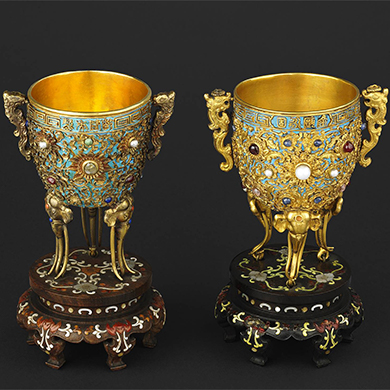
Gold Cup of Eternal Stability, Qing Dynasty
Gold Cup of Eternal Stability, Qing Dynasty
© The Wallace Collection
There are two Gold Cup of Eternal Stability in the Wallace Collection. The one on the left is made of gilt bronze, and the one on the right is made of high-karat gold. The cups are inlaid with pearls, sapphire, emerald, red agate and other precious stones on kingfisher blue ground. The handles are shaped as stylized dragons and the three legs of each cup are in the shape of elephant heads, symbolizing peaceful times. These cups are for the exclusive use of the emperor. “Gold Cup of Eternal Stability” signifies eternal territorial integrity. There is another Gold Cup of Eternal Stability in the collection of the Palace Museum in Beijing.

Rhinoceros horn libation cup carved with lotus leave and sprigs, Ming Dynasty
Rhinoceros horn libation cup carved with lotus leave and sprigs, Ming Dynasty
Provided by the Palace Museum
Rhinoceros horn libation cups gradually became popular during the Ming Dynasty. Such cups are made of precious materials and are often used for toasting. Li Yu (1611 – 1680) writes in his book Pleasant Diversion, “Rhinoceros horn libation cups give good wine a special fragrance… jade improves colours and rhinoceros horn adds fragrance. Both offer good company for wine.” This shows that people at that time believed rhinoceros horn libation cups could enhance the fragrance of wine.
This cup is made of an intact rhinocero’s horn. The cup is carved in the round into a lotus leave with sprigs of leaves, flowers and seed pod. The spout is an integral part of the cup rather than a separate section affixed to the body. It is formed by bending the tip of the rhinocero’s horn with heat after carvings are done.


Famille rose figure of Zhong Kui, Qing Dynasty
Famille rose figure of Zhong Kui, Qing Dynasty
Provided by the Palace Museum
Even the usually hideous-looking Zhong Kui, the Ghost-eater, cannot resist the temptation of good wine and looks at peace.


Silver enamelled wine warmer, Qing Dynasty
Silver enamelled wine warmer, Qing Dynasty
Provided by the Palace Museum
The outer pot in the shape of a hexagonal cylinder holds hot water. It is clad with cloisonné enamel, mainly silver enamel, decorated with plum blossoms, orchid, bamboo and chrysanthemum, and is vivid in colour. The cylindrical inner pot, complete with spout, lid and double loop handle, holds wine. With this warmer, warm wine is available in the cold winter in the Forbidden City.

Gold temperance thumb ring, Qing Dynasty
Gold temperance thumb ring, Qing Dynasty
Provided by the Palace Museum
In the Forbidden City, there is warning against over indulgence in drinking. By wearing a thumb ring carved with the warning “quit drinking”, one is always reminded to resist the temptation of good wine.

Fruits, Cakes and Pastries
During the Ming and Qing dynasties, fruits and pastries were always served at banquets and regular meals in the Forbidden City. The Qing court continued the popular custom of consuming fruits and desserts, and a Fruit Pantry was set up specifically to supply the court with dried and fresh fruit. A wide range of fruits were eaten, including dried pears, goji berries, cantaloupes, grapes, oranges, betel nuts, dried mandarin peels, lotus seeds and longan fruit. Specially made preserved fruits, candied plums and osmanthus syrup were also served. The Qing court at the time had an enormous collection of vessels for serving fruit. Trays and serving dishes and boxes divided into movable compartments were often used.

Birthday Gathering in the Bamboo Garden by Lü Wenying (1421 –1505) and Lü Ji, (circa 1439 –1505), Ming Dynasty
Birthday Gathering in the Bamboo Garden by Lü Wenying (1421 –1505) and Lü Ji (circa 1439 –1505), Ming Dynasty
Provided by the Palace Museum
Large bamboo baskets containing fruit such as longevity peaches, as well as wine cups, bowls, wine jugs and picnic boxes can be seen on the table.

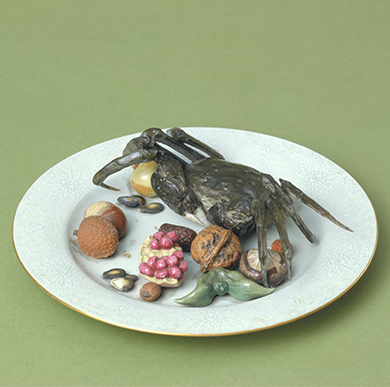
Plate with famille rose, trompe l’oeil porcelain fruit, Qing Dynasty
Plate with famille rose, trompe l’oeil porcelain fruit, Qing Dynasty
Provided by the Palace Museum
This highly-realistic trompe-l’oeil porcelain fruit plate includes items that signify good wishes, such as red dates, lychee, water chestnut, pomegranate, peanuts, lotus seeds, and melon seeds. Lychee symbolises good fortune; chestnuts and pomegranate have the meaning of “the more sons, the more happiness”; red dates, peanuts and melon seeds convey the wish of “may you soon give birth to sons”.


Footed dish with famille rose, trompe l’oeil porcelain fruit, Qing Dynasty
Footed dish with famille rose, trompe l’oeil porcelain fruit, Qing Dynasty
Provided by the Palace Museum
The footed dish holds a box in the shape of a tangerine, surrounded by walnuts, mulberries, cherries, water chestnuts, pomegranate, mandarin oranges and dates.


Lobed oval Zitan wood box inlaid with Eight Immortals design, Qing Dynasty
Lobed oval Zitan wood box inlaid with Eight Immortals design, Qing Dynasty
Provided by the Palace Museum
Made with choice materials such as stained ivory and lapis lazuli, this is a classic example of the lavish sectioned boxes used in the Forbidden City during the Qing Dynasty.
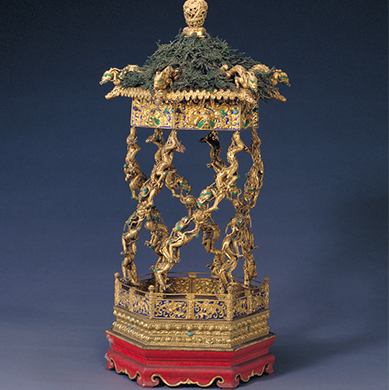
Gilt-bronze pine canopy fruit basket, Qing Dynasty
Gilt-bronze pine canopy fruit basket, Qing Dynasty
Provided by the Palace Museum
The pine canopy fruit basket was used for displaying fruit at celebratory banquets in the imperial palace.


Famille rose carved and inlaid lotus citron dish, Qing Dynasty
Famille rose carved and inlaid lotus citron dish, Qing Dynasty
Provided by the Palace Museum
The citron dish is a type of small fruit dish displayed in the scholars’ studios in ancient China.











